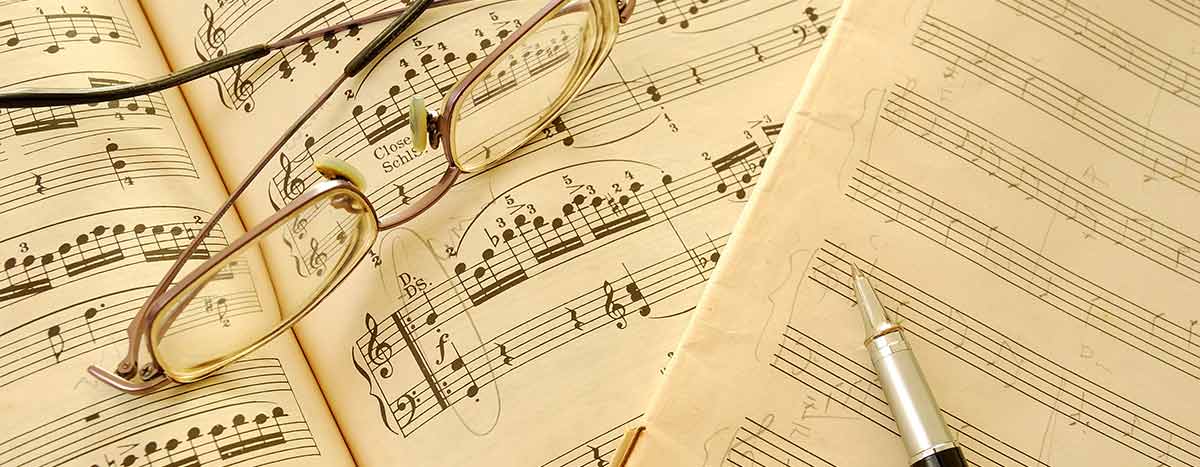How to Start Interpreting Your Piano Piece: The First Four Aspects to Consider
Interpreting your piano piece well is one of the most important aspects when playing, whether for your own enjoyment or for an exam. You can have all the technique or maybe not that great a technique yet, but playing your piece musically and with musical expression will make playing and listening to yourself a great pleasure.
Of course, one has to always better their technique as without proper technique, parts of your playing will always not sound great. For now, I want to give attention to how to interpret your piece and where to start.

1. The Name of Your Piece
The first important aspect in interpretation is usually the very first thing on your page. It's the name of your piece. The name most often indicates how your piece has to sound like. For instance, if it's called a Mazurka - you would expect the Mazurka dance feel with its marked “three-quarter-notes-per-bar” timing and an accent on the second and/or third beat. It helps to have an idea of how the Mazurka sounds. Here is a short explanation of the Mazurka and its interpretation by E-MusicMaestro
The Mazurka is a dance in triple time originating in Poland in the 16th century. It has a characteristic accent on the second and/or third beat and was originally accompanied by a bagpipe drone.
A student with some flair for the dramatic in performance, and a strong sense of pulse, will play this well. The mixture of articulations may defeat a less well-coordinated student. Dynamics need to be fully realised and accents marked. Neatness and accuracy will be important underpinnings to a successful performance, to enable the student to play with confidence.
The same way it helps to know how the Minuet sounds if your piece is called a Minuet. It is a dance from the Baroque and early Classical period. Listening to the sound of different Minuets will help you to understand how your Minuet has to sound.

2. The Period It Was Written In
The period in which the piece was written often indicates how it should be interpreted. Pieces from the Baroque period are mostly played without any use of the pedal, as the sustaining pedal developed only in the Classical period. So when doing a piece of music from the Baroque period - use very little pedal if any at all. When we come to composers like Beethoven from the Late Classical period or even more so Chopin, from the Romantic period or Debussy, from the Impressionist period, much more pedalling is used. Following your pedalling instructions are quite important in creating the correct feel for your piece.
I was recently working with a student doing a Chopin Mazurka. We had to give special attention to the pedal markings indicated as they were not the usual legato pedalling found in many pieces but rather pedalling to enhance the music.
With legato pedalling one has to keep the pedal down until the next chord or note is played in order to create a legato passage without a break in the melody line or sound. In the Mazurka, however, the pedal has to come up on or just after every 3rd beat in order to create the Mazurka feel where there is a break in sound on the third beat, creating the specific Mazurka dance feel. It would help you to go and listen to a few interpretations of good artists playing Chopin Mazurkas in order to understand the sound.

3. The Composer
So how do you know which period a piece is written in? After looking at the name of your piece which will indicate the style you will be playing in, then look at the composer and when they lived. Some pieces of music are not from a specific period but might be written as if in a specific period. Especially pieces written today by contemporary composers.
If your piece is written by JS Bach for instance, it will help a lot to go and listen to some Bach pieces on Youtube so as to have an idea of the music interpretation of this period. Music in the Baroque period is mostly contrapuntal and it means that there are equal melodies moving against one another and the important “trick” here is to let each line stand out on its own against another equally important line. So your ear has to clearly hear each line moving in each voice or melody line. In a four-voice Fugue, this can be quite daunting to hear and play all four lines against one another with only two hands!

4. Dynamics and Metronome Markings
The very next indication on your piece will probably be a dynamic interpretation probably written in Italian. Italian markings are typically used for the indication of musical dynamics. You might ask, “what is musical dynamics?” It is simple instructions on your score to indicate how the composer played or wants his music to be performed. I give an example: ‘p’ which is an abbreviation for ‘piano’ and translated as ‘soft’, means to play softly. There will be many piano markings like Cres. or Dim. and many others on your score. You could easily find all these markings on Google today which makes research easy for piano students.The very first marking at the start of your piece often indicates feel or speed.
Let's look at a piece from Chopin: Nocturne Opus 9 nr1. First of all we see that it's called a Nocturne which means its music to be played gently and probably at night. Normally a gentle piece of music. This is as it is put in the Britannica:
Nocturne, (French: “Nocturnal”), in music, a composition inspired by, or evocative of, the night, and cultivated in the 19th century primarily as a character piece for piano.
The name therefore already gives us an indication that the piece will be played gently and probably a bit slowly. In this specific piece the very first Italian name given to indicate speed and interpretation is the word: ‘Largetto’. Next to it you will probably find a metronome indication. Take note, it's only an indication and not a set speed. In this case the editor, Rafael Joseffy, put it at the speed of 166 for each quarter note or crochet note beat. The word ‘Largetto’ means rather slow and broad. This helps you to know that you can think and play ’rather slow’ and ‘broad’ in this piece and not rush it at all.
After looking at all the very obvious but often overlooked names, composer’s name, period of composition or era, tempo indications, etc., it's time to look at your piece. The former four principles should never be overlooked because of eagerness to get to the actual playing of the music. At some time, do stop and do the research. Give detailed attention to these points if you are serious about your interpretation.
Now it's time to go through your entire piece and look at every dynamic marking and know its meaning. Write it onto your page if you need to. Use your sheet music as a working pad and write all over it in an effort to make it your own. An empty page without markings means there is a lot you missed. Normally students hesitate to write on their music sheet, but it helps a lot when you do your markings on your sheet music. I do, however, suggest that you do not overmark your page with fingering every single note or mark your counting throughout the whole piece. You could mark a few bars until you understand the timing and only mark the fingers really necessary.
I trust that the above first basics will help you with getting started on your interpretation of a piece of music! So get going and enjoy it! It's so much fun to follow and to understand these markings, periods, and composers. Enjoy!
About the Author: Sonja Joubert
How to Start Interpreting Your Piano Piece: The First Four Aspects to Consider
Interpreting your piano piece well is one of the most important aspects when playing, whether for your own enjoyment or for an exam. You can have all the technique or maybe not that great a technique yet, but playing your piece musically and with musical expression will make playing and listening to yourself a great pleasure.
Of course, one has to always better their technique as without proper technique, parts of your playing will always not sound great. For now, I want to give attention to how to interpret your piece and where to start.
1. The Name of Your Piece
The first important aspect in interpretation is usually the very first thing on your page. It's the name of your piece. The name most often indicates how your piece has to sound like. For instance, if it's called a Mazurka - you would expect the Mazurka dance feel with its marked “three-quarter-notes-per-bar” timing and an accent on the second and/or third beat. It helps to have an idea of how the Mazurka sounds. Here is a short explanation of the Mazurka and its interpretation by E-MusicMaestro
The same way it helps to know how the Minuet sounds if your piece is called a Minuet. It is a dance from the Baroque and early Classical period. Listening to the sound of different Minuets will help you to understand how your Minuet has to sound.
2. The Period It Was Written In
The period in which the piece was written often indicates how it should be interpreted. Pieces from the Baroque period are mostly played without any use of the pedal, as the sustaining pedal developed only in the Classical period. So when doing a piece of music from the Baroque period - use very little pedal if any at all. When we come to composers like Beethoven from the Late Classical period or even more so Chopin, from the Romantic period or Debussy, from the Impressionist period, much more pedalling is used. Following your pedalling instructions are quite important in creating the correct feel for your piece.
I was recently working with a student doing a Chopin Mazurka. We had to give special attention to the pedal markings indicated as they were not the usual legato pedalling found in many pieces but rather pedalling to enhance the music.
With legato pedalling one has to keep the pedal down until the next chord or note is played in order to create a legato passage without a break in the melody line or sound. In the Mazurka, however, the pedal has to come up on or just after every 3rd beat in order to create the Mazurka feel where there is a break in sound on the third beat, creating the specific Mazurka dance feel. It would help you to go and listen to a few interpretations of good artists playing Chopin Mazurkas in order to understand the sound.
3. The Composer
So how do you know which period a piece is written in? After looking at the name of your piece which will indicate the style you will be playing in, then look at the composer and when they lived. Some pieces of music are not from a specific period but might be written as if in a specific period. Especially pieces written today by contemporary composers. If your piece is written by JS Bach for instance, it will help a lot to go and listen to some Bach pieces on Youtube so as to have an idea of the music interpretation of this period. Music in the Baroque period is mostly contrapuntal and it means that there are equal melodies moving against one another and the important “trick” here is to let each line stand out on its own against another equally important line. So your ear has to clearly hear each line moving in each voice or melody line. In a four-voice Fugue, this can be quite daunting to hear and play all four lines against one another with only two hands!
4. Dynamics and Metronome Markings
The very next indication on your piece will probably be a dynamic interpretation probably written in Italian. Italian markings are typically used for the indication of musical dynamics. You might ask, “what is musical dynamics?” It is simple instructions on your score to indicate how the composer played or wants his music to be performed. I give an example: ‘p’ which is an abbreviation for ‘piano’ and translated as ‘soft’, means to play softly. There will be many piano markings like Cres. or Dim. and many others on your score. You could easily find all these markings on Google today which makes research easy for piano students.The very first marking at the start of your piece often indicates feel or speed.
Let's look at a piece from Chopin: Nocturne Opus 9 nr1. First of all we see that it's called a Nocturne which means its music to be played gently and probably at night. Normally a gentle piece of music. This is as it is put in the Britannica:
The name therefore already gives us an indication that the piece will be played gently and probably a bit slowly. In this specific piece the very first Italian name given to indicate speed and interpretation is the word: ‘Largetto’. Next to it you will probably find a metronome indication. Take note, it's only an indication and not a set speed. In this case the editor, Rafael Joseffy, put it at the speed of 166 for each quarter note or crochet note beat. The word ‘Largetto’ means rather slow and broad. This helps you to know that you can think and play ’rather slow’ and ‘broad’ in this piece and not rush it at all.
After looking at all the very obvious but often overlooked names, composer’s name, period of composition or era, tempo indications, etc., it's time to look at your piece. The former four principles should never be overlooked because of eagerness to get to the actual playing of the music. At some time, do stop and do the research. Give detailed attention to these points if you are serious about your interpretation.
Now it's time to go through your entire piece and look at every dynamic marking and know its meaning. Write it onto your page if you need to. Use your sheet music as a working pad and write all over it in an effort to make it your own. An empty page without markings means there is a lot you missed. Normally students hesitate to write on their music sheet, but it helps a lot when you do your markings on your sheet music. I do, however, suggest that you do not overmark your page with fingering every single note or mark your counting throughout the whole piece. You could mark a few bars until you understand the timing and only mark the fingers really necessary.
I trust that the above first basics will help you with getting started on your interpretation of a piece of music! So get going and enjoy it! It's so much fun to follow and to understand these markings, periods, and composers. Enjoy!
Share this article!
Women and the Saxophone: Emerging Voices Shaping the Future of the Instrument
The history of the saxophone is filled with legendary names—Marcel Mule, Stan Getz, Charlie Parker—and they all have one thing in common: they are men. From the classical stage to jazz clubs, [...]
Portrait of Olivier Messiaen and His Musical Language Through Time
Born on 10 December 1908 in Avignon, France, Messiaen became a major composer of 20th-century music. He was the son of Pierre Messiaen, a literature professor who... [...]
Learning the Violin: A Demanding Journey Guided by Relaxation
The violin is often considered one of the most difficult instruments to learn. It requires great precision, a keen ear, and subtle coordination between the hands. Yet, at its core... [...]
What makes the saxophone unique among wind instruments?
As a saxophonist, I often hear amused remarks from other musicians claiming that the saxophone belongs to the brass family—a common misunderstanding due to its appearance [...]
Improving breath control and lung capacity as a beginner saxophonist
Breath control is one of the major challenges for beginner saxophonists. Many struggle to sustain long phrases and run out of breath before completing a musical line. Without proper technique, [...]
History of the Double Bass
The double bass emerged in 1620, succeeding the violone and the violone bass, but it was not introduced into the orchestra until the mid-17th century. It was first used in an orchestra [...]
SIMILAR ARTICLES
Join Paris’ most distinguished music academy for adults
Exclusive music instruction for adults of all ages and abilities (absolute beginners are very welcome!)